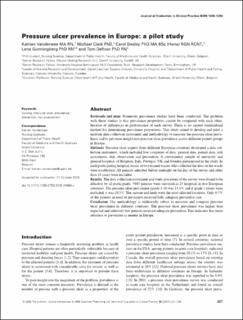| dc.contributor.author | Vanderwee, K. | |
| dc.contributor.author | Clark, M. | |
| dc.contributor.author | Dealey, C. | |
| dc.contributor.author | Gunningberg, L. | |
| dc.contributor.author | Defloor, T. | |
| dc.date.accessioned | 2021-07-09T11:50:10Z | |
| dc.date.available | 2021-07-09T11:50:10Z | |
| dc.date.issued | 2007 | |
| dc.identifier.citation | Vanderwee, K., Clark, M., Dealey, C., Gunningberg, L. & Defloor, T. (2007). Pressure ulcer prevalence in Europe: A pilot study. Journal of Evaluation in Clinical Practice, 13(2), 227–35. | en_US |
| dc.identifier.uri | https://hdl.handle.net/11250/2764058 | |
| dc.description.abstract | Rationale and aims Numerous prevalence studies have been conducted. The problem with these studies is that prevalence proportions cannot be compared with each other, because of differences in performance of each survey. There is no agreed standardized method for determining prevalence proportions. This study aimed to develop and pilot a uniform data collection instrument and methodology to measure the pressure ulcer prevalence and to get some insight into pressure ulcer prevalence across different patient groups in Europe.
Methods Pressure ulcer experts from different European countries developed a data collection instrument, which included five categories of data: general data, patient data, risk assessment, skin observation and prevention. A convenience sample of university and general hospitals of Belgium, Italy, Portugal, UK and Sweden participated in the study. In each participating hospital, teams of two trained nurses who collected the data on the wards were established. All patients admitted before midnight on the day of the survey and older than 18 years were included.
Results The data collection instrument and study procedure of the survey were found to be effective by all participants. 5947 patients were surveyed in 25 hospitals in five European countries. The pressure ulcer prevalence (grade 1–4) was 18.1% and if grade 1 ulcers were excluded, it was 10.5%. The sacrum and heels were the most affected locations. Only 9.7% of the patients in need of prevention received fully adequate preventive care.
Conclusion The methodology is sufficiently robust to measure and compare pressure ulcer prevalence in different countries. The pressure ulcer prevalence was higher than expected and relatively few patients received adequate prevention. This indicates that more attention to prevention is needed in Europe. | en_US |
| dc.publisher | Journal of Evaluation in Clinical Practice | en_US |
| dc.subject | nursing | en_US |
| dc.subject | pressure ulcer | en_US |
| dc.subject | prevalence | en_US |
| dc.subject | prevention | en_US |
| dc.subject | risk assessment | en_US |
| dc.subject | trykksår | en_US |
| dc.subject | pasientsikkerhet | en_US |
| dc.title | Pressure ulcer prevalence in Europe: A pilot study | en_US |
| dc.type | Journal article | en_US |
| dc.source.pagenumber | 227-235 | en_US |
| dc.source.volume | 13 | en_US |
| dc.source.journal | Journal of Evaluation in Clinical Practice | en_US |
| dc.source.issue | 2 | en_US |
| dc.identifier.doi | https://doi.org/10.1111/j.1365-2753.2006.00684.x | |
| dc.description.localcode | måsjekkes | |
